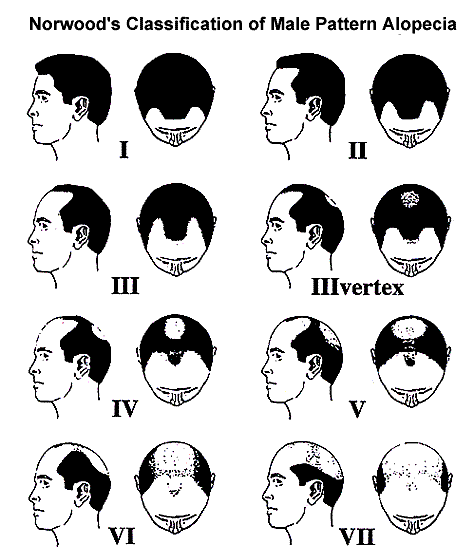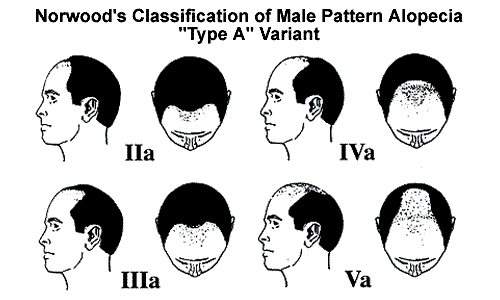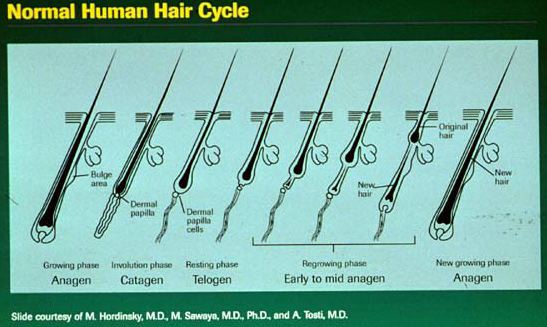Male pattern baldness is a common problem among men. It is a natural phenomenon that is normally related with aging; however, it can affect anyone. In the normal hair growth cycle, everyone loses about hundred hairs a day. Up to fifty percent of all men face this problem at some point of time in their whole life (Kivi & Solan, par. 2). But excessive hair loss can be distressing and depressing and becomes a major cause of concern for the affected person (Salamon, par. 1).
Male pattern hair loss is also known as Androgenetic alopecia (AGA). Normally, it starts at the forehead and then draws back the hairline down the sides. The remaining hair may also become thinner and shorter. How much hair a man may lose depends on his genetics.
Forms of male pattern baldness
Male pattern hair loss or AGA can be seen in two forms.
Frontal hair loss: Frontal hair loss can be seen on the forehead which does not create any effect on the top of the head, the crown area.
Vertex hair loss: Vertex hair loss can be observed on the top of the head which is crown area and does not touch the hairline of the forehead (Liu & Aspres, par. 2).
Dr O’tar Norwood has described male hair loss through various normally used classifications. The classification, published in 1975, describes two chief patterns of male baldness. It includes “a bitemporal recession and thinning crown- gradually enlarge and coalesce until the entire front, top and crown (vertex) of the scalp are bald” (“Classification of Hair Loss in Men” par.1).

- Class 1: This class does not actually represent balding rather shows the adolescent hairline that rests on the upper brow line.
- Class2: This class represents the adult or mature hairline. The hairline shows some temporal decline and rests one finger above the upper brow line. However, this also is not a sign of balding.
- Class3: This class shows the early signs of male balding in the crown area. There is an expanding temporal downturn seen.
- Class4: At this stage, expanded frontal hair loss and extension of vertex is quite visible. Nevertheless, the division of front and vertex with a solid band of hair can be observed.
- Class 5: The band of hair between the front and crown diminishes.
- Class 6: This classification depicts the picture of large bald area on the front and top of the scalp. The hairline on the sides is still high.
- Class 7: Here, one can observe only a band of hair left on the sides and at the back of the scalp.
Norwood Class A
This class represents the patterns of hair fall starting from front to backward. There is no connecting band of hair across the top of the scalp and less hair fall is likely to occur in the crown.

The Norwood Class A patterns are not much responsive to the medication and require surgical restoration at an early stage. Men with this kind of baldness are more receptive to hair transplantation (“Classification of Hair Loss in Men”, par.3).
Causes of hair loss
Hair loss can occur due to many reasons including illness, strain due to some surgery, sessions of radiotherapy and chemotherapy, as a result of some fungal infections, hormonal problems, side-effects of certain medications and blemishes from burns. Certain health conditions lead to sudden hair loss redness, scaling and soreness (Liu & Aspres, par.4).
“Male pattern hair loss largely relates to a person’s inherited genetic sensitivity to the effects of dihydrotestosterone or DHT in certain areas of the scalp. The age of starting hair fall, its pattern, sequence and severity depends on various genes of a particular family. Not only men but also women with excessive androgen levels and genetic tendency may show the signs of pattern baldness. Hair follicles are substituted at different rates by the normal course of hair cycling” (“Male Pattern Hair Loss”, par.2). There are different stages of hair growth movement and rest. “The growth period or the anagen phase continues for two to six years. This is the stage when the follicle is deep and long producing thick and well-pigmented hair. The second stage or catagen phase lasts for a few weeks when the follicle shrivels and lastly the telogen phase that remains for two to four months shrinking the follicle even more” (“Male Pattern Hair Loss”, par.2). It is again followed by the anagen phase when a new hair takes place of the older one after it falls out (“Male Pattern Hair Loss”, par.2).

According to experts, the male pattern baldness relates to the defects in the development of hair. Baldness does not occur only due to the lack of hair; instead the new hair grows so small that it cannot be seen with the naked eye. Therefore, the hairline seems to be shrinking, creating the typical bald mark. According to the US team studying this matter, the stem cells producing new hair are responsible for this malfunction. They believe that male baldness can be treated by re-establishing the normal function of these cells. A study conducted by the University of Pennsylvania established that the number of stem cells in both bald areas and hairy areas was equal but the matured cell known as the progenitor cells, were less. According to Dr.George Cotsarelis, who was leading this research, “This implies that there is a problem in the activation of stem cells in bald scalp.” He further added that, “The fact that there are normal numbers of stem cells in bald scalp, gives us hope for reactivating those stem cells” (Roberts, par. 5).
“In a research on the pattern male baldness it is observed that the defect in conversion of hair follicle stem cells to progenitor cells is responsible for the pathogenesis of common baldness or AGA in men” (Garza,et.al , par. 4), Paus & Cotssarelis,( n.d.) state that “In AGA, large terminal follicles diminish in size with time, and the resulting miniaturized follicle eventually produces a microscopic hair. “Miniaturization of the follicle takes place as the hair follicle cycles. All follicles continuously cycle from growing stage (anagen), to an involutional stage (catagen), and then to a resting stage (telogen), before again entering anagen.”(as cited in Garza,et.al , par. 2). The cause of AGA is the smallness of the new lower hair follicle at the stage of inception. According to Price (1999), “Testosterone is necessary for miniaturization, and type 5-α-reductase type II inhibitors, which block conversion of testosterone to its more active form, dihydrotestosterone, delay progression of AGA.” (as cited in Garza et al, par. 2).
An androgen by the name of Testosterone is found in men, which helps in normal generative and sexual functioning. The testosterone converts into dihydrotestosterone (DHT) and works on the hair follicles along with acting on the other parts of the body. Sometimes, due to increased sensitivity of the hair follicles to DHT, hair growth is affected resulting into weak and short hair (Liu & Aspres, par. 6).
Genes vs. Environment: Various researches have indicated that genetic factors play greater role in male pattern baldness than environmental factors. Androgens, male sex hormones, are responsible for doing many functions in men that takes account of ruling hair growth. Though many researches are being conducted to study if there are any risky features of this condition, still many of the issues are unidentified (“Androgenetic alopecia”, par.2).
Investigators have dogged that this type of hair loss can be connected with hormones, androgens. These hormones are very important for men before birth and during puberty (“Androgenetic alopecia”, par.2).
Follicles are the elements which play main role in the growth of hair under skin. Androgenetic alopecia happens when hair follicles start lessening (‘Male Pattern Baldness”, par.3). Normally a single hair grows for a few years and after sometime it is substituted by a new hair strand. It is a normal cycle of a hair growth. The hair follicle is lesser in the case of male pattern baldness. It grows tinier and better strands and in due course of time stops growing” (Kivi & Solan, par. 6).
The most known cause of male pattern baldness is heredity that is normally harmless. Male pattern baldness can be checked by the pattern of hair loss. The small hair loss is most of the time not much noticeable since we have about 100,000 hairs on our head and the lost hairs are normally substituted by new hair but it does not happen always. Hair loss can happen in many years or sometimes suddenly. It could be everlasting or for the short-term (Kivi & Solan, 2012).
A person could be losing more hair than it is normal if one finds that (Kivi & Solan, 2012):
- After washing hair there is a big amount of hair in the drain
- Clomps of hair while brushing
- Thin patches of hair
- One experiences baldness
There are both unknown and known genetic factors like SNPs which are responsible for male pattern baldness. “The researches show that there are many genes which affect androgenetic alopecia but variations in one gene, that is AR, have been recognized. The AR gene gives instructions for making protein, which is called androgen receptor” (“Androgenetic Alopecia”, par. 6). With the help of AR the body is able to respond to dhydrotestosterone and other androgens. The deviation in androgen receptor (AR) gene is responsible for reducing the age of hairs of men. This is the stage when men start losing hair and become bald. There was a long established notion that male pattern baldness was caused by a single gene that was passed on by mother on the X chromosome. It was also believed that the hair loss would occur in a typical manner and women were less prone to this type of pattern baldness. AR gene exists in the X chromosome. It is commonly understood that baldness is normally inherited from mother to son. A man inherits X chromosome from his mother. He has one X chromosome. “A man having baldness-promoting version of the AR is believed that he has received it from his mother. But his mother receives one X chromosome from her mother and one from her father. It makes sense that baldness could have come from man’s maternal grandfather” (“Male Pattern Baldness”, par. 7).
Another SNP, which is chromosome 20, has been interrelated with male pattern baldness. Though its influence on the gene is not yet known. Still more researches are required to know the effect of this SNP on male pattern baldness (“Male Pattern Baldness”, par. 7).
A research done by Markus Nothen, a genomics professor at Germany’s University of Bonn and his colleagues also reveal that gene variation becomes the cause of hair loss. “As X chromosome plays vital role in this, which is inherited by men through their mothers, one can have an idea of the future of his scalp by seeing the men from his mother’s side’ (Hitti, par. 2).
A survey was done on 95 families by the team of Nothen. In the group there were at least two brothers having premature male pattern hair loss. In total 200 men, who were affected with hair loss, participated in this survey.
In a news release Nothen said that, “Genetic screening showed that the ‘cardinal prerequisite’ for premature male pattern baldness was a variation in the androgen receptor gene. The gene variant was found “very much more often” among prematurely bald men than among men who still had a full head of hair after age 60” (Hitti, par. 9).
Alex Hillmer, the colleague of Nothen revealed that though the particular mechanisms are not recognized, yet gene variation contributes in enhancing the impact of androgens that becomes the main cause of hair loss (Hitti, par. 10).
According to the study, baldness can be affected by other genes too, which the men can inherit from their fathers. Nothen mentions “We have indications that other genes are involved, which are independent of the parents’ sex. So hair loss could be a father-son inheritance too” (Hitti, par. 12).
One more small study was conducted in 1916 encompassing 22 families. However, recent researches put forward a more intricate situation. These researches establish that the there are multiple genes responsible for male pattern baldness and these genes are not necessarily coming from the mother’s side. Further, these researches also reveal that there is an additive effect attached with each engrossed gene. According to a major Australian study published in the Journal of Investigative Dermatology, there was no clear pattern of inheritance or gene predisposition found accountable for male pattern baldness. Further, a strong connection between the baldness tendencies of fathers and sons was evident in the study. However, there are greater chances of developing baldness in men if either the mother’s side or the father’s side has a tendency of male baldness (Ray, par. 4).
Keeping in view the possibility of two or more genes linkage, liable for the development of male pattern baldness, a study was conducted by Hillmer et al in 2008. It focused on the testing of “genome- scan data for interaction between the X chromosomal region containing the AR gene locus and all autosomal loci” (Hillmer et al, 2008, Para 8) The study relative to the genome –wide linkage scans for AGA susceptibility loci suggests, “AGA susceptibility genes in autosomal regions showing evidence for linkage confer their risk through pathways other than the classical androgen pathway” (Hillmer et al, par. 9).
Treatment
Surgery: The process of surgery is to attach tiny plugs of hair in the scalp which is affected with baldness. The source of these plugs is the hairy areas of the scalp. This process may cause threat of skin infection to some extent. Scars may also occur on the scalp in this process. This process involves several sessions and can be exorbitant, however, yields satisfactory and stable results (Liu & Aspres, par. 8).
Medicines: Besides surgery, there are some medicines too that can have a positive effect on stopping the pattern baldness in men. These medicines can prevent or slower hair loss. Sometimes new hair growth is also observed in some men. The two chief medicines used for this purpose are Finasteride and Minoxidil (Liu & Aspres, par. 8).
Finasteride: “This medicine also known as Propecia ®, comes in the form of tablet and helps in preventing the conversion of testosterone to DHT, thereby not affecting the follicles and allowing the hair to grow normally” (Liu & Aspres, par. 8).
Not all men taking Finasteride may show signs of hair regrowth but in most cases, the hair fall reduces to a major extent. The hair grows mostly in the crown. People need to take the treatment on regular basis for its stability and no significant side effects of the medicine are observed except a loss of sex drive in very few men (Liu & Aspres, par. 9).
Minoxidil: This lotion is also known as Rgaine®, Hair Retreva® or Hair a-gain®. This lotion is applied on the scalp to prevent balding. Delaying of balding or hair regrowth appears after rubbing this lotion on the scalp daily for four months. There are no noticeable side effects of the medicine except for some cases skin irritation and rash.
Myths about male pattern hair loss: There are many myths prevailing related to the pattern hair loss in men. Some people suggest that standing on one’s head may prevent the process of balding by increasing the blood flow to the hair follicles. However, there are no evidences backing this blood-flow theory. “Another myth related to the pattern hair loss in men is that the genetic causes are passed down from the mother’s side. However, genetics is the main cause of male baldness but there are several genes liable for it and they may come from the side of mother or father both” (Salamon, par. 4).
Moreover, there is a myth that people with higher levels of male sex hormones testosterone are affected with male pattern hair loss; however, the increased levels of testosterone cannot be associated with male pattern baldness (Liu & Aspres, par. 8).
Natural or alternative therapies: The National Institute of Arthritis and Musculoskeletal and Skin Diseases declares that there are no medical researches backing the alternative therapies for hair fall treatment, but Chinese herbs, zinc and vitamin supplements, evening primrose and aroma therapy and acupuncture may be helpful in improving alopecia areata. However, any therapy or treatment should be taken after consultation with the physician (Salamon, par. 4).
References
Androgenetic alopecia, 2013. Web.
Classification of hair loss in men. 2013. Web.
Garza, Luis A, Yang, Chao Chun, Blatt, Hanz B., Lee, Michelle, He, Helen, Stanton, David C., Carrasco, Lee, Spiegel, Jeffery H., Tobias, John W. & Cotsarelis, George. “Bald scalp in men with androgenetic alopecia retains hair follicle stem cells but lacks CD200-rich and CD34-positive hair follicle progenitor cells.” J Clin Invest. 121.2 (2011):613–622. Web.
Hillmer, Axel M.,Flaquer, Antonia, Hanneken, Sandra, Eigelshoven, Sibylle, Kortum, Anne-Katrin, Brockschmidt, Felix F., Golla, Astrid, Metzen, Christine, Thiele, Holger, Kolberg, Susanne, Reinartz, Roman, Betz, Regina C., Ruzicka, Thomas, Hennies, Hans Christian, Kruse, Ronald & Nothen, Markus M. “Genome-wide scan and Fine-Mapping linkage study of Androgenetic Alopecia reveals a locus on chromosome 3q26.” Am J Hum Genet. 3; 82.3 (2008):737–743. Web.
Hitti, Miranda. “Blame male pattern baldness on mom?”Webmed. 2005. Web.
Kivi, Rose & Solan, Matthew. “Male pattern baldness.”Healthline. 2012. Web.
Liu, A/Professor Peter Y & Aspres, Dr Nicholas. “Factsheet- Male pattern hair loss.” 2013. Web.
Male pattern baldness, 2013. Web.
Male Pattern Hair Loss, 2013. Web.
Ray, Claiborne C. “Genes and baldness.” 2004. Web.
Roberts, Michal. “Cause of male baldness discovered, experts say.” 2011. Web.
Salamon, Maureen. “Hair loss and balding: Causes, symptoms & treatments.”Livescience. 2013. Web.